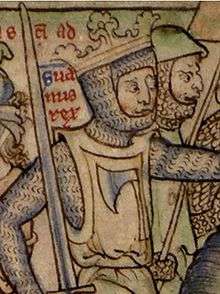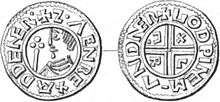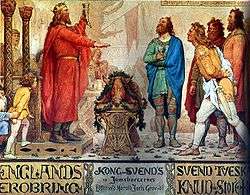Sweyn Forkbeard
| Sweyn Forkbeard | |
|---|---|
 | |
| King of Denmark | |
| Reign | 986–1014 |
| Predecessor | Harald Bluetooth |
| Successor | Harald II |
| King of Norway | |
| Reign |
|
| Predecessor | |
| Successor | Olaf II |
| King of England | |
| Reign | 1013–1014 |
| Predecessor | Æthelred |
| Successor | Æthelred |
| Born |
c. 960 Denmark |
| Died |
3 February 1014 Gainsborough, Lincolnshire |
| Burial | Roskilde Cathedral or St. Trinity in Lund |
| Spouse | Świętosława / Sigrid/ Gunhild (detail) |
| Issue among others... | |
| House | House of Denmark |
| Father | Harald Bluetooth |
| Mother | Gunhild or Tove |
| Religion | Chalcedonian Christianity |
Sweyn Forkbeard (Old Norse: Sveinn Tjúguskegg; Danish: Svend Tveskæg; 960 – 3 February 1014) was king of Denmark, England, and parts of Norway. His name appears as Swegen in the Anglo-Saxon Chronicle.[1] He was the son of King Harald Bluetooth of Denmark, and the father of Cnut the Great.
In the mid-980s, Sweyn revolted against his father and seized the throne. Harald was driven into exile and died shortly afterwards in November 986 or 987.[2] In 1000, with the allegiance of Trondejarl, Eric of Lade, Sweyn ruled most of Norway. In 1013, shortly before his death, he became the first Danish king of England after a long effort.
Biography
Family and early life
Many details about Sweyn's life are contested. Scholars disagree about the various, too often contradictory, accounts of his life given in sources from this era of history, such as the Anglo-Saxon Chronicle, Adam of Bremen's Deeds of the Bishops of Hamburg, and the Heimskringla, a 13th-century work by Icelandic author Snorri Sturluson.[3] Conflicting accounts of Sweyn's later life also appear in the Encomium Emmae Reginae, an 11th-century Latin encomium in honour of his son king Cnut's queen Emma of Normandy, along with Chronicon ex chronicis by Florence of Worcester, another 11th-century author.
The Dictionary of National Biography states that his mother's name is unknown,[2] but the Danish encyclopedia Den Store Danske identifies her as Tove from the Western Wendland. Den Store Danske identifies Sweyn's wife as Gunhild, widow of Erik, king of Sweden,[4] but the Dictionary of National Biography, while agreeing that she was Erik's widow, describes her as an unnamed sister of Boleslav, ruler of Poland.[2]


Many negative accounts build on Adam of Bremen's writings; Adam is said to have watched Sweyn and Scandinavia in general with an "unsympathetic and intolerant eye", according to some scholars.[5] Adam accused Forkbeard of being a rebellious pagan who persecuted Christians, betrayed his father and expelled German bishops from Scania and Zealand. According to Adam, Sweyn was sent into exile by his father's German friends and deposed in favour of king Eric the Victorious of Sweden, whom Adam wrote ruled Denmark until his death in 994 or 995.
Historians generally have found problems with Adam's claims, such as that Sweyn was driven into exile in Scotland for a period as long as fourteen years. As many scholars point out, he built churches in Denmark throughout this period, such as Lund and Roskilde, while he led Danish raids against England.[6]
Invasions of England
The "Chronicle of John of Wallingford" (c. 1225–1250) records Sweyn's involvement in raids against England during 1002–1005, 1006–1007, and 1009–1012 to revenge the St. Brice's Day massacre of England's Danish inhabitants in November 1002. Sweyn was believed to have had a personal interest in the atrocities, with his sister Gunhilde and her husband possibly amongst the victims.[7]
Sweyn campaigned in Wessex and East Anglia in 1003–1004, but a famine forced him to return to Denmark in 1005. Further raids took place in 1006–1007, and in 1009–1012 Thorkell the Tall led a Viking invasion into England. Simon Keynes regards it as uncertain whether Sweyn supported these invasions, but "whatever the case, he was quick to exploit the disruption caused by the activities of Thorkell's army".[8]
Some scholars have argued that Sweyn's participation may have been prompted by his state of impoverishment after having been forced to pay a hefty ransom. He needed revenue from the raids.[6] He acquired massive sums of Danegeld through the raids. In 1013, he is reported to have personally led his forces in a full-scale invasion of England.[9]
The contemporary Peterborough Chronicle (also called the Laud Manuscript), one of the Anglo-Saxon Chronicles, states:
before the month of August came king Sweyn with his fleet to Sandwich. He went very quickly about East Anglia into the Humber's mouth, and so upward along the Trent till he came to Gainsborough. Earl Uchtred and all Northumbria quickly bowed to him, as did all the people of the Kingdom of Lindsey, then the people of the Five Boroughs. He was given hostages from each shire. When he understood that all the people had submitted to him, he bade that his force should be provisioned and horsed; he went south with the main part of the invasion force, while some of the invasion force, as well as the hostages, were with his son Cnut. After he came over Watling Street, they went to Oxford, and the town-dwellers soon bowed to him, and gave hostages. From there they went to Winchester, and the people did the same, then eastward to London.[10]
But the Londoners put up a strong resistance, because King Æthelred and Thorkell the Tall, a Viking leader who had defected to Æthelred, personally held their ground against him in London itself. Sweyn then went west to Bath, where the western thanes submitted to him and gave hostages. The Londoners then followed suit, fearing Sweyn's revenge if they resisted any longer. King Æthelred sent his sons Edward and Alfred to Normandy, and himself retreated to the Isle of Wight, and then followed them into exile.[10] On Christmas Day 1013 Sweyn was declared King of England.
Based in Gainsborough, Lincolnshire, Sweyn began to organise his vast new kingdom, but he died there on 3 February 1014, having ruled England for only five weeks. His embalmed body was returned to Denmark for burial in the church he had built himself. Tradition locates this church in Roskilde,[8] but it is more plausible that it was actually located in Lund in Scania (now part of Sweden).[11] Sweyn's elder son, Harald II, succeeded him as King of Denmark, but the Danish fleet in England proclaimed his younger son Cnut king. In England, the councillors had sent for Æthelred, who upon his return from exile in Normandy in the spring of 1014 managed to drive Cnut out of England. But Cnut returned and became King of England in 1016, eventually also ruling Denmark, Norway, parts of Sweden, Pomerania, and Schleswig.
Sweyn's son Cnut and Cnut's own sons Harold Harefoot and Harthacnut ruled England for 26 years. After Harthacnut's death, the English throne reverted to the House of Wessex in the person of King Edward the Confessor (reigned 1042–1066).
Sweyn's descendants through his daughter Estrid continue to reign in Denmark to this day. One of his descendants, Margaret of Denmark, married James III of Scotland in 1469, introducing Sweyn's bloodline into the Scottish royal house. After James VI of Scotland inherited the English throne in 1603, Sweyn's descendants became monarchs of England again.
The Church and currency

On the northern edges of the relatively recent Holy Roman Empire, with its roots in Charlemagne's conquests about two hundred years prior to Sweyn's time, Sweyn Forkbeard had coins made with an image in his likeness. The Latin inscription on the coins read, "ZVEN REX AD DENER", which translates as "Sven, king of the Danes".[12][13]
Sweyn's father, Harald Bluetooth, was the first of the Scandinavian kings to accept Christianity officially, in the early or mid-960s. According to Adam of Bremen, an 11th-century historian, Harald's son Sweyn was baptised Otto, in tribute to the German king Otto I,[14] who was the first Holy Roman Emperor. Forkbeard is not known to have ever officially made use of this Christian name.
Religion

Adam of Bremen's writings about Sweyn and his father may have been influenced by Adam's desire to emphasise Sweyn's father Harald as a candidate for sainthood. He claimed that Sweyn, who was baptised along with his father, was a heathen. This may have been true, as much of Scandinavia was pagan at the time, but there is no data to corroborate the assertion. German and French records support that Harald Bluetooth was baptised.
According to Adam, Sweyn was punished by God for leading the uprising which led to king Harald's death, and had to spend "fourteen years" abroad – perhaps a Biblical reference from an ecclesiastical writer, as it refers to the symbolic number seven. Adam purports that Sweyn was shunned by all those with whom he sought refuge, but was finally allowed to live for a while in Scotland. Adam's intention appeared to be to show that Sweyn belonged with heathens and was not fit to rule a Christian country. According to Adam, Sweyn only achieved success as a ruler after accepting Christianity.
Sweyn was tolerant of paganism while favouring Christianity, at least politically. By allowing English ecclesiastical influence in his kingdom, he was spurning the Hamburg-Bremen archbishop. Since German bishops were an integral part of the secular state, Sweyn's preference for the English church may have been a political move. He sought to pre-empt any threat against his independence posed by the German kings.[15] Contrary to Adam's writings, Sweyn did not appear to have re-established paganism. There is no evidence of reversion to pagan burial practices during Sweyn's reign.[16] Whether King Sweyn was a heathen or not, he enlisted priests and bishops from England rather than from Hamburg.[15] This may have been another reason for Adam of Bremen's apparent hostility in his accounts. Numerous converted priests of a Danish origin from the Danelaw lived in England, while Sweyn had few connections to Germany or its priests.
Sweyn must have known that once the Archbishop of Hamburg-Bremen gained influence in Denmark, the German Emperor Otto II would not be far behind. His Slavic neighbours to the south-east had been all but annexed by Germany once Otto's father Otto I divided their lands into bishoprics and put them under the "care" of the Holy Roman Emperor. Sweyn may have envisaged the same happening to his own territory.
Issue
Sweyn had eight children with Sigrid the Haughty and Gunhild of Wenden:
Popular culture
- King Sweyn Forkbeard is a character in the historical novels The Long Ships by Frans Gunnar Bengtsson and A Hollow Crown by Helen Hollick.
- Sweyn Forkbeard is a primary antagonist in the manga Vinland Saga by Makoto Yukimura.
- King Sweyn Forkbeard is played by Ernest Graves in the 1970 film The Ceremony of Innocence.
References
- ↑ The Anglo-Saxon Chronicle. Manuscripts C, D, and E. Edited by Jebson, Tony. Accessed 18 August 2011.
- 1 2 3 Sawyer, P. H. (2004). "Swein (Sveinn Haraldsson, Sveinn Tjúguskegg, Swein Forkbeard) (d. 1014), king of England and of Denmark". Oxford Dictionary of National Biography. Oxford University Press. doi:10.1093/ref:odnb/26830. Retrieved 27 February 2013. (subscription or UK public library membership required)
- ↑ Howard, Ian (2003). Swein Forkbeard's Invasions and the Danish Conquest of England, 991– 1017. Woodbridge: Boydell Press. pp. 7–8. ISBN 0-85115-928-1.
- ↑ "Svend 1. Tveskæg". Den Store Danske. Retrieved 27 February 2013.
- ↑ Sørensen, M. P. (2001). "Religions Old and New", The Oxford Illustrated History of the Vikings. Ed. P. H. Sawyer. Oxford University Press (2001), pg. 202
- 1 2 Lund, Niels (2001). "The Danish Empire and the End of the Viking Age", The Oxford Illustrated History of the Vikings. Ed. P. H. Sawyer. Oxford University Press, 2001, p. 167–181. ISBN 0-19-285434-8.
- ↑ Mike Ashley, British Monarchs; A complete genealogy, gazetteer and biographical Encyclopaedia of the Kings and Queens of Britain, Robinson Publishing (1998) p.483: "Probably his [Æthelred's] worst decision was the St. Brice's day massacre on 13 November 1002...he ordered the killing of every Dane who lived in England, except the Anglo-Danes in the Danelaw. The massacre brought back to English shores the Danish commander Swein, whose sister and brother-in-law had been killed in the massacre".
- 1 2 Keynes, Simon (2001). "Swein Forkbeard". In Lapidge, Michael; Blair, John; Scragg, Donald. The Blackwell Encyclopaedia of Anglo-Saxon England. London: Blackwell Publishing. p. 437. ISBN 0-631-15565-1.
- ↑ Blair, Peter Hunter (2003). An Introduction to Anglo-Saxon England (3rd ed.). Cambridge University Press. p. 98. ISBN 0-521-53777-0.
- 1 2 The Anglo-Saxon Chronicle. Everyman Press: London, 1912. Translation by James Ingram (London, 1823) and J. A. Giles (London, 1847). Online Medieval and Classical Library Release #17. Retrieved 12 October 2006.
- ↑ http://www.medievalhistories.com/sweyn-forkbeard/
- ↑ The National Museum of Denmark. The Royal Collection of Coins and Medals. Accessed 18 Aug 2011.
- ↑ Ministry of Foreign Affairs of Denmark (2006). Coinage in Denmark. Official web site. Accessed 12 October 2006
- ↑ Adam of Bremen Gesta II.3. Ed. Schmeidler, trans. Tschan, pg. 56
- 1 2 Lund, Niels (1986). "The armies of Swein Forkbeard and Cnut: leding or li(th)" Anglo-Saxon England 15 (1986), p. 39–40.
- ↑ Sawyer, Peter (1987). "The Process of Scandinavian Christianization in the Tenth and Eleventh Centuries" in The Christianization of Scandinavia, Birgit Sawyer, et al., ed. Kungälv: Viktoria Bokforlag, p. 80. ISBN 91-86708-04-X.
External links
| Wikimedia Commons has media related to Sweyn Forkbeard. |
- Swein 1 at Prosopography of Anglo-Saxon England
- Northvegr (Scandinavian) – A History of the Vikings (Search)
- Vikingworld (Danish) – Swein Forkbeard (Svend Tveskæg)
- Sweyn Forkbeard: The Viking King of England on Medieval Archives Podcast
| Regnal titles | ||
|---|---|---|
| Preceded by Harald Bluetooth |
King of Denmark c. 985–1014 |
Succeeded by Harald II |
| King of Norway c. 985–995 |
Succeeded by Olaf I | |
| Preceded by Olaf I |
King of Norway 1000–1014 |
Succeeded by Olaf II |
| Preceded by Æthelred the Unready |
King of the English 1013–1014 |
Succeeded by Æthelred the Unready |
